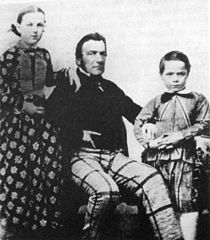Charles Pellegrini
| Charles Pellegrini | |
|---|---|

Charles Pellegrini with his eldest children,
Julia and Carlos |
|
| Born | 28 July 1800 Chambéry, Savoy, present-day France |
| Died | October 12, 1875 (aged 75) Buenos Aires |
| Nationality | Italian and Argentine |
Charles Henri Pellegrini (28 July 1800 – 12 October 1875) was an Italian Argentine engineer, lithographer, painter, and architect.
Charles Henri Pellegrini was born in Chambéry, Savoie in 1800 when the region was occupied by French revolutionary forces. His mother, Marguerite Berthet, was French, and his father, Bernardo Pellegrini, was a Swiss-Italian from Coglio, Canton Ticino, in the Italian-speaking part of Switzerland. Pellegrini was a talented sketch artist at an early age, and his drawings earned a prize while he was still in primary school. He enrolled at the University of Turin and later at the École Polytechnique, near Paris, where he earned an engineering degree.
Pellegrini was contracted as an engineer by Juan Larrea, a prominent Spanish Argentine merchant with interest in Bordeaux, by request of President Bernardino Rivadavia, and he arrived in Buenos Aires in November 1828. He took a post in the Hydraulic Engineering Department. The bureau, however, was decommissioned in 1829 by order of the Governor of Buenos Aires, General Juan José Viamonte.
He then returned to his early talent, drawing, and sold a number of watercolour paintings, notably cityscape impressions. He was hired by his fellow countryman, journalist and lithographer César Hipólito Bacle, in October 1830 as a portrait painter, and by the end of his commission in September 1831, he had earned around 17,000 pesos (around US$700). He continued to live as a successful lithographer and painter until 1837, when he purchased an estancia, La Figura, in Cañuelas.
...
Wikipedia
